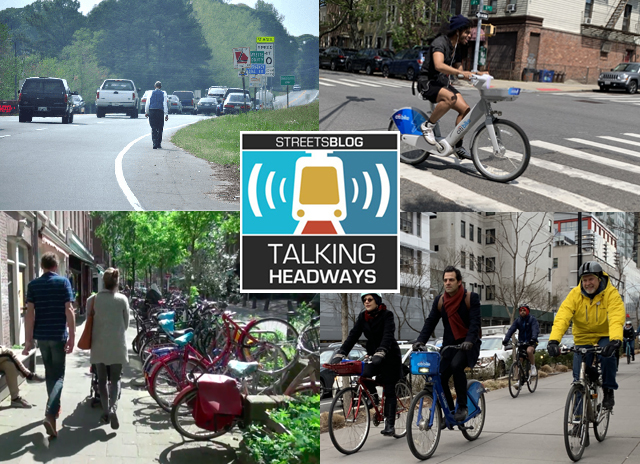This week, Billie Giles-Corti, director of the Healthy Livable Cities Lab at RMIT, Melanie Lowe of the University of Melbourne, and Geoff Boeing of USC, talk about their papers in The Lancet Global Health series: How does walkability contribute to public health? How does Sao Paulo connect policy and outcomes? How can cities can use bus-stop and intersection density for positive health outcomes?
For those of you who prefer to read rather than listen, check out the edited highlights below the player. If you want a full, unedited transcript, be our guest by clicking here.
Jeff Wood: It seems like a lot of the cities have policies ... because maybe it looks good to have a health policy on the books rather than that [it] might actually accomplish something. So I like this idea that you’re holding their feet to the fire with the indicators, because it seems like, from the policy perspective, at least some of these cities are saying a lot but not actually doing things.
Melanie Lowe: That’s definitely what we found. Some cities were better or worse at that, but really across the 25 cities, there was a lack of those specific and measurable policy targets. So lots of aspirations stated — policy rhetoric around creating healthy, sustainable, even equitable cities — but when you look at the detail, there wasn’t that specificity to back it up. So you kind of left with a lack of those measurable targets to guide implementation and hold governments accountable. We also looked at if the contents were consistent with what creates healthy built environments.
The vast majority of policies broadly do support those goals, even if they’re just general aspirations, rather than those targets that we need. We found, however, that some policy statements and policy targets were actually contrary to what we know and ... particularly we found some cities didn’t have sufficiently ambitious targets for walking and cycling or public transport use. So you set the benchmark too low and, therefore: Where’s the drive for the transformation of our urban environments to shift from car cities, to ones that have sustainable and active transport systems? Another area where there was a lack of ambition for some cities was in low housing density targets.
We need adequate housing density to support nearby destinations and therefore walkability. That was an area with low ambition for some cities. So, these things need to be urgently revised, particularly if you’ve got a specific target that lacks ambition; you’re really setting the benchmark too low and potentially locking cities into unsustainable and unhealthy urban systems, which are not going to help us address the health and sustainability challenges of this century.
Wood: I saw somewhere somebody wanted a 5 percent share for biking and walking, and that was their ambition. I shrugged my shoulders at that.
Lowe: In the U.S., we included Baltimore, Seattle and Phoenix. It was Baltimore that you’re referring to, that had a target by 2040 to have a 5 percent walking, cycling mode share to work. Alone, it sounds like it’s pretty low, but particularly when we look at international comparisons, it really stands out. So, a place like Odense, Denmark, is an exemplar of cycling target. It had a target of something like 45 percent of trips to work being by bike and within a shorter timeframe. So, you see the huge gap in ambition between that city and Baltimore. Certainly we found that the Australian cities and the U.S. cities had the most car-centric policy frameworks, and that’s perhaps not a surprise.
Geoff can talk more to this, but we also found that those cities, similarly, when you look at the built environments, had lowest levels of walkability,
Wood: Well, that’s an interesting thing about walkability: Why is walkability such an important factor in this whole discussion? And how does that connect to the outcomes in terms of health that you’re looking for? Because it seems like reading through the papers that walkability was one of the key ideas that ties the health part of it to the transportation, urban-design part.
Billie Giles-Corti: One thing you can do for your health is to be physically active. It’s really the silver bullet. There’s nothing you can do that’s more health promoting even in the face of other risk factors. Being physically active is really a fantastic thing that people can do just for their own health. We know that walking is something that’s popular. So more people do more walking than any other physical activity. So we might think that going to the gym is important. People don’t need to go to the gym to get health benefit, to be physically active. They just need to walk more. It sounds pretty obvious if you live in a walkable environment, you’re more likely to walk.
If you can walk to the local shops and there’s some characteristics of a walkable environment — the key thing to a walkable environment is local destinations. When you’ve got really low density, you don’t have enough people to make those shop services and public transport viable, so you have very few shops and services to walk to. If you’ve got nowhere to walk, people don’t walk.
The other thing that we include in our walkability index is the connectivity of the street network. Because if you live in an area where there’s lots of cul-de-sacs, it’s a very circuitous route to get anywhere. People just tend to drive. Whereas if you’ve got a very connected street network where you’ve got lots of different routes that you can take, so if there’s a dog down there that you don’t like, or there’s some houses that you might like to look at, ... you can go and take lots of different routes. So, street connectivity, levels of density [are important], not because density is important in itself, but because it makes the destinations more viable. It’s really the destinations that are so critical because, if you don’t have destinations, you won’t walk.
The other thing, of course, is what’s really important is to reduce the amount of traffic because we don’t measure traffic per sale. I think we should, because what we know for cardiovascular disease that exposure to air pollution is really damaging to health. In fact, now air pollution is the fourth-leading cause of global mortality. You know, around 8 million people die every year because of exposure to air pollution from cars; cars are one of the biggest contributors to that.
So, you know, these built-environment measures are really important for chronic disease or cardiovascular health. We used to worry in cities about communicable diseases, infectious disease, but now what we worry about is the impact of cities on non-communicable diseases or chronic diseases, the major ones that are preventable and causing so much ill health and premature mortality.






